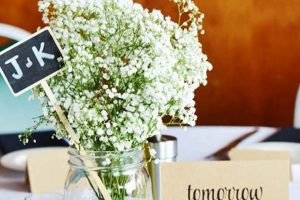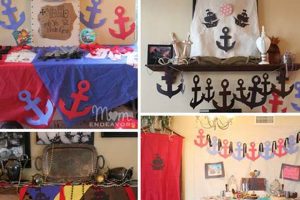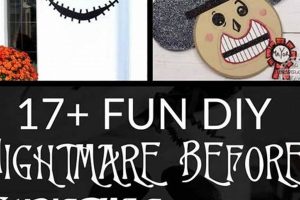Constructing customized ornaments and embellishments related to the Harry Potter book and film series allows enthusiasts to express their fandom through creative, hands-on projects. Examples encompass crafting Hogwarts house banners, brewing imitation potions for display, or designing wands inspired by various characters.
Engaging in such activities fosters resourcefulness, provides personalized thematic elements for celebrations or room decor, and potentially reduces expenditure compared to purchasing commercially produced merchandise. Historically, fan-created items have been a significant element of fandom culture, reflecting individual interpretation and passion for the source material.
The subsequent sections will provide guidance on selecting materials, executing specific project ideas, and ensuring the safety and longevity of these handcrafted tributes to the wizarding world.
Crafting Memorable Wizarding World Ambiance
The following guidance facilitates the creation of bespoke decorative elements inspired by the Harry Potter universe. Prioritization of safety and adherence to established craft techniques are essential.
Tip 1: Utilize Authentic Color Palettes. Research the specific shades associated with each Hogwarts house (Gryffindor: scarlet and gold; Hufflepuff: yellow and black; Ravenclaw: blue and bronze; Slytherin: green and silver) to ensure accurate representation in banners, flags, and other themed items.
Tip 2: Employ Recycled Materials. Repurpose cardboard boxes for constructing miniature castles or potion ingredient containers. Glass jars can be transformed into decorative potion bottles with appropriate labeling and coloring.
Tip 3: Master Basic Crafting Techniques. Familiarity with fundamental skills such as paper mache, simple sewing, and basic painting techniques will significantly expand the range of achievable projects.
Tip 4: Incorporate Textural Elements. Introduce varied textures through the use of feathers (for Quidditch-themed items), twine (for aged-looking scrolls), and various fabrics (for house-themed scarves or banners) to enhance visual interest.
Tip 5: Prioritize Safety with Adhesives and Paints. Select non-toxic adhesives and paints, particularly when involving children in the crafting process. Ensure proper ventilation during application and drying to mitigate potential health risks.
Tip 6: Preserve Finished Items. Protect completed creations from dust and environmental damage by applying a sealant or clear coat. Store delicate items in protective containers to prolong their lifespan.
Effective application of these methods allows for the creation of immersive and visually compelling decorations that evoke the atmosphere of the wizarding world.
The subsequent section will discuss project ideas and detailed instruction.
1. Authenticity of Design
The faithfulness with which a handmade decorative item reflects the source material, in this case, the Harry Potter universe, significantly impacts its perceived value and contribution to the desired atmosphere. Authenticity dictates the level of immersion and recognition achieved within a themed environment.
- Canonical Accuracy
The degree to which the design adheres to established details within the books and films. This encompasses accurate representation of colors, shapes, sizes, and materials of iconic objects or settings. For example, a house banner should accurately reproduce the house crest and color scheme according to established iconography. Deviations from canonical accuracy may diminish the perceived quality and thematic consistency.
- Material Appropriateness
The selection of materials should be congruous with the perceived function and aesthetic of the object being replicated. While literal replication may not always be feasible within the constraints of a do-it-yourself project, the chosen materials should evoke a similar texture and visual effect. Constructing a wand, for instance, may involve the use of wood, resin, or polymer clay, each offering varying degrees of authenticity in terms of weight, texture, and appearance.
- Symbolic Consistency
The incorporation of symbols and motifs that are readily identifiable within the Harry Potter universe is crucial for establishing authenticity. This includes the correct application of runes, sigils, and other visual cues that contribute to the overall narrative. Erroneous or misplaced symbolism can detract from the immersive experience and undermine the intended thematic effect. For example, the placement of the Deathly Hallows symbol on an item intended to represent a specific Hogwarts house may create thematic dissonance.
- Stylistic Coherence
Maintaining a consistent stylistic approach throughout the design and construction process is essential for achieving a cohesive and authentic result. This involves considering the overall aesthetic of the Harry Potter universe and avoiding the introduction of elements that are incongruent with that aesthetic. For instance, incorporating overly modern or anachronistic design elements into a medieval-themed decoration may detract from its authenticity.
Achieving authenticity in handcrafted ornamentation necessitates a thorough understanding of the source material and a meticulous attention to detail in design and execution. The successful application of these principles elevates the quality of handcrafted homages to the wizarding world.
2. Material Selection
The selection of appropriate materials is a critical determinant of the aesthetic quality, durability, and overall success of “diy harry potter decorations”. Inadequate material choices can compromise the visual fidelity of the project, reduce its longevity, and potentially pose safety hazards. The link between material selection and successful execution of “diy harry potter decorations” is a causal relationship, with judicious selection leading to enhanced project outcomes. For example, opting for paper-based materials when constructing a decorative element intended for outdoor display will inevitably result in deterioration and a shortened lifespan.
Consider the creation of a potion bottle display. Clear glass bottles, cork stoppers, and non-toxic dyes would be essential materials. Substitution of plastic bottles would diminish the authenticity and visual appeal, while using unsafe dyes could pose a health risk. Similarly, when crafting a replica of a Hogwarts house scarf, the choice between acrylic yarn and wool significantly impacts the texture, warmth, and overall perceived quality. Wool, though potentially more expensive, provides a more authentic feel and drape, enhancing the realism of the item. These practical examples illustrate how material selection directly influences the final product’s quality and the degree to which it accurately represents elements from the Harry Potter universe.
In summary, careful consideration of material properties, availability, and cost-effectiveness is paramount in the domain of “diy harry potter decorations”. Challenges such as sourcing specific materials or replicating unique textures may necessitate creative problem-solving and adaptation. Nonetheless, a deliberate approach to material selection is fundamental to realizing the creative vision and ensuring the enduring appeal of these handmade tributes to the wizarding world. The understanding of the relationship between material selection and the final product ensures a better result for individuals engaging in Harry Potter DIY activities.
3. Crafting Techniques
The skillful application of various crafting techniques forms the bedrock upon which successful “diy harry potter decorations” are built. The execution quality directly influences the aesthetic impact, structural integrity, and overall faithfulness to the source material. Proficiency in these techniques allows for the translation of creative vision into tangible, compelling representations of the wizarding world.
- Paper Mache Application
Paper mache, a versatile and economical technique, facilitates the creation of three-dimensional objects and decorative elements. Its application extends to crafting replicas of the Sorting Hat, constructing miniature models of Hogwarts castle, or fabricating decorative orbs for potion displays. The process involves layering strips of paper soaked in adhesive over a mold or armature, requiring patience and precision to achieve a smooth and durable finish. Insufficient layering or uneven adhesive application can result in a structurally weak and visually unappealing outcome. The success of paper mache in “diy harry potter decorations” hinges on mastering the art of layering and smoothing.
- Basic Sewing Proficiency
Sewing skills are essential for producing fabric-based ornamentation, such as house banners, character-inspired apparel, or decorative pillows. The ability to execute straight stitches, secure seams, and apply embellishments enables the creation of durable and visually accurate representations of textiles within the Harry Potter universe. A poorly sewn seam or uneven hemline can detract from the overall quality of a fabric-based decoration. When crafting a replica of a Hogwarts house scarf, for instance, knowledge of knitting or crocheting can further enhance the authenticity and detail of the project. Precision and attention to detail in sewing are paramount for achieving a professional-looking result.
- Painting and Finishing
The application of paint and various finishing techniques significantly impacts the visual appeal and longevity of “diy harry potter decorations”. This encompasses the proper use of acrylic paints, varnishes, and sealants to achieve desired colors, textures, and protective coatings. Painting techniques include layering, shading, and highlighting to create depth and realism. A well-executed paint job can transform a simple craft project into a visually stunning piece of decor. Conversely, uneven application, brushstrokes, or an inappropriate choice of paint can diminish the quality of the final product. The careful selection and application of appropriate finishes are crucial for protecting the finished decoration from damage and ensuring its lasting visual appeal.
- Sculpting and Molding
Sculpting and molding techniques are applicable for creating intricate details and three-dimensional elements, such as character figurines, wand handles, or decorative embellishments. The use of materials like polymer clay or resin allows for the creation of durable and detailed representations of iconic objects from the Harry Potter universe. Skillful sculpting requires precision, patience, and an understanding of form and proportion. Molding techniques, such as casting resin into silicone molds, enable the replication of intricate designs with relative ease. In “diy harry potter decorations”, proficiency in sculpting and molding unlocks the potential for creating highly detailed and visually compelling pieces.
Mastering these fundamental crafting techniques empowers individuals to realize their creative visions and produce high-quality, visually compelling “diy harry potter decorations” that faithfully represent the magic and wonder of the Harry Potter universe.
4. Scale and Proportion
The principles of scale and proportion are integral to the successful creation of “diy harry potter decorations”. Proper application of these principles ensures visual harmony, functional utility, and thematic coherence, contributing to a more immersive and believable representation of the wizarding world. Disregard for scale and proportion can result in decorations that appear jarring, impractical, or incongruous with the intended aesthetic.
- Relative Sizing of Objects
The relationship between the dimensions of different decorative elements within a single display or setting must be considered. For example, a miniature Hogwarts castle intended for a tabletop display should be appropriately sized relative to accompanying figures or accessories. A castle towering disproportionately over its surroundings would appear unnatural and detract from the overall effect. The relative sizing influences the believability of the representation, necessitating careful planning and accurate measurements.
- Proportion Within Individual Items
Each individual decoration must adhere to accurate proportions within its own design. A wand, for instance, should possess a handle and shaft whose lengths are proportionate to one another, reflecting the established aesthetic of wands as depicted in the Harry Potter films. A wand with an excessively long handle or an unusually thick shaft would appear awkward and undermine its credibility as a magical artifact. Accurate proportions are critical for capturing the authentic visual identity of iconic objects.
- Contextual Appropriateness of Scale
The overall scale of the decorations must be appropriate for the intended setting. Oversized decorations in a small space can create a cluttered and overwhelming effect, while undersized decorations in a large space may appear insignificant and lost. A life-sized replica of the Triwizard Tournament Cup might be suitable for a large event venue but impractical for a small apartment. The scale must be considered in relation to the available space and the desired level of visual impact.
- Usability and Functionality Considerations
Scale and proportion also influence the usability of functional decorations. A replica of the Marauder’s Map, for example, should be sized appropriately for practical use as a decorative wall hanging or tabletop display. A map that is too large or too small would be difficult to handle and appreciate. Similarly, decorative potion bottles should be sized appropriately for display on a shelf or mantle, avoiding excessive weight or instability. The scale should align with the intended function and ensure ease of use.
In conclusion, careful consideration of scale and proportion is paramount in the design and execution of “diy harry potter decorations”. These principles dictate the visual harmony, functional utility, and overall success of the decorations, contributing to a more immersive and believable representation of the wizarding world.
5. Durability of Construction
The correlation between construction durability and the longevity of “diy harry potter decorations” is direct and consequential. Robust construction methods, encompassing secure adhesion, reinforced structures, and protective finishes, directly contribute to the resistance of these handcrafted items against wear, tear, and environmental factors. Lack of attention to durable construction precipitates premature degradation, diminishing the decorative value and necessitating frequent repairs or replacements. A house banner constructed with flimsy fabric and weak seams, for instance, will likely fray and tear with minimal handling, negating its intended decorative purpose. Similarly, a wand crafted from brittle material is susceptible to breakage during even casual use, diminishing its value as a collectible or prop. The durability of construction serves as a critical determinant of the sustained visual appeal and functional lifespan of “diy harry potter decorations”.
Practical implementation of durability principles involves several key considerations. The appropriate selection of adhesives, such as industrial-strength glue for attaching components of a model or weatherproof sealant for outdoor decorations, directly influences the structural integrity and resistance to environmental degradation. Reinforcing vulnerable areas, such as the joints of a miniature building or the wings of a paper mache creature, with additional layers of material or internal supports can significantly enhance its resilience. Applying protective finishes, such as varnish or sealant, to painted surfaces or delicate materials shields against scratches, moisture damage, and fading from ultraviolet exposure. These preventative measures prolong the lifespan of handcrafted items and preserve their aesthetic qualities. The application of durability principles in “diy harry potter decorations” transforms the project into lasting representations of the wizarding world.
Effective durability ultimately influences the long-term value and satisfaction derived from crafted items. Recognizing and addressing potential weaknesses in construction materials and processes ensures the enduring quality and aesthetic appeal of “diy harry potter decorations”. While the initial time investment may be greater, the resultant increase in longevity provides enhanced return on effort and promotes sustainable practices, extending the enjoyment and lifespan of the creative endeavors. A sturdy construction helps ensure the “diy harry potter decorations” not only look good but also remain a lasting tribute to the beloved franchise.
6. Color Palette Consistency
Color palette consistency exerts a pivotal influence on the authenticity and visual appeal of “diy harry potter decorations”. A coherent and accurate color scheme fosters immediate recognition and reinforces the thematic connection to the source material. Conversely, deviations from established color palettes can diminish the credibility of the decorations, leading to a diluted or confusing aesthetic. The cause-and-effect relationship is evident: meticulous adherence to canonical colors enhances immersion, while inconsistent color usage undermines the desired effect. For example, Gryffindor decorations utilizing maroon and gold, instead of the canonically correct scarlet and gold, would dilute the immediate recognition and established symbolism. Achieving visual coherence necessitates a thorough understanding of the established color schemes for Hogwarts houses, characters, and objects.
Practical application of color palette consistency extends beyond simply identifying the correct hues. It also involves considering the undertones, saturation, and intensity of colors, and the ways in which these elements interact with one another. A Hufflepuff-themed banner, for example, requires a nuanced understanding of the specific shades of yellow and black associated with the house, and how these colors are balanced to create a visually harmonious composition. A vibrant, overly saturated yellow might appear garish, while a dull, muted black could lack visual impact. Similarly, Slytherin decorations demand careful consideration of the metallic sheen associated with silver, and how this effect is replicated through paint or other media. The application of techniques such as color mixing, layering, and shading further enhances the depth and complexity of the color palette.
In summary, color palette consistency serves as a cornerstone in the creation of believable and visually compelling “diy harry potter decorations”. Addressing challenges in color matching, material selection, and artistic execution necessitates a commitment to accuracy and attention to detail. Ultimately, achieving chromatic fidelity contributes significantly to the overall success of the decorative project, enhancing its impact and reinforcing its connection to the beloved wizarding world. Ignoring color consideration will inevitably result in a less persuasive aesthetic. The attention to color palette consistency ensures greater success in DIY efforts, as this effort translates directly into an increase in visual quality for the viewer.
7. Thematic Relevance
Thematic relevance acts as a critical anchor in the realm of “diy harry potter decorations,” establishing a direct correlation between the crafted item and the source material’s established narrative, symbolism, and aesthetic. Decorations lacking thematic relevance, even if technically proficient, fail to resonate effectively within the intended context, diminishing their impact and diluting the overall atmosphere. This principle dictates that each handcrafted element should demonstrably connect to specific aspects of the Harry Potter universe, whether through direct representation of iconic objects, characters, or settings, or through subtle allusions to underlying themes and motifs. Without thematic relevance, “diy harry potter decorations” become generic fantasy-themed items, losing their specific connection to the beloved franchise.
Practical application of thematic relevance necessitates a comprehensive understanding of the Harry Potter books and films. Crafting a replica of the Monster Book of Monsters, for instance, requires accurately replicating its appearance, including its characteristic biting action and the use of appropriately textured faux fur. A generic book with no indication of its monstrous nature would lack the necessary thematic relevance. Similarly, creating decorations inspired by specific scenes or characters necessitates careful consideration of their defining traits and attributes. A display commemorating the Yule Ball should incorporate elements such as ice sculptures, elegant attire, and orchestral music, reflecting the formal and festive atmosphere of the event. Furthermore, decorations can allude to more subtle themes, such as the power of friendship, the importance of courage, or the triumph of good over evil, through the use of symbolic imagery and motifs.
In essence, thematic relevance provides the essential framework for creating meaningful and impactful “diy harry potter decorations”. Addressing challenges in accurately representing complex themes or sourcing appropriate materials necessitates a commitment to research and attention to detail. Adherence to thematic consistency strengthens the connection between the decorations and the source material, enhancing their overall appeal and creating a more immersive and authentic representation of the wizarding world. Disregarding thematic relevance renders the created pieces insignificant and does not successfully evoke a sense of the Harry Potter world. This concept ensures viewers understand and appreciates the decorative pieces more successfully.
Frequently Asked Questions About DIY Harry Potter Decorations
This section addresses common inquiries regarding the creation and implementation of handcrafted decorative elements inspired by the Harry Potter universe. The information provided aims to clarify potential uncertainties and offer practical guidance.
Question 1: Is specialized equipment necessary for creating DIY Harry Potter decorations?
The extent of specialized equipment required depends on the complexity of the project. Basic crafting tools such as scissors, glue guns, and paintbrushes are generally sufficient for simpler endeavors. More intricate projects involving woodworking or sculpting may necessitate specialized tools like saws, chisels, or molding equipment. Prior evaluation of project requirements is recommended before acquiring specialized equipment.
Question 2: What safety precautions should be observed when undertaking DIY Harry Potter decoration projects?
Safety precautions are paramount, particularly when involving children in crafting activities. The use of non-toxic materials, adequate ventilation when working with paints or adhesives, and careful handling of sharp tools are essential. Adult supervision is mandatory for projects involving potentially hazardous materials or equipment.
Question 3: How can the authenticity of DIY Harry Potter decorations be enhanced?
Authenticity is achieved through meticulous attention to detail and adherence to established canons. Thorough research of the books and films, accurate color palettes, and faithful reproduction of iconic symbols and objects contribute to enhanced authenticity. Utilizing officially licensed reference materials can aid in achieving accurate representations.
Question 4: What is the most cost-effective approach to sourcing materials for DIY Harry Potter decorations?
Cost-effectiveness can be achieved through the utilization of recycled materials, repurposing existing items, and strategic sourcing from discount retailers or online marketplaces. Planning projects in advance and purchasing materials in bulk can further reduce expenses. Consideration of alternative materials that offer similar aesthetic qualities at a lower cost is also advisable.
Question 5: How can the longevity of DIY Harry Potter decorations be maximized?
Longevity is enhanced through the implementation of robust construction techniques, the application of protective finishes, and proper storage practices. Utilizing durable materials, securing joints with strong adhesives, and applying varnishes or sealants to painted surfaces contribute to extended lifespan. Storing delicate items in protective containers shields them from dust, moisture, and physical damage.
Question 6: What are some common pitfalls to avoid when creating DIY Harry Potter decorations?
Common pitfalls include neglecting safety precautions, overlooking attention to detail, disregarding thematic relevance, and failing to adequately plan projects in advance. Rushing the crafting process, utilizing substandard materials, and neglecting proper finishing techniques can also compromise the quality and longevity of the decorations.
In summary, successful execution of DIY Harry Potter decorations requires careful planning, adherence to safety guidelines, and attention to detail in material selection and construction techniques. A thorough understanding of the source material is essential for achieving authenticity and thematic relevance.
The subsequent section will address advanced techniques and project ideas for creating sophisticated DIY Harry Potter decorations.
Conclusion
This exploration of “diy harry potter decorations” has underscored the importance of authenticity, material selection, crafting techniques, scale, durability, color palette consistency, and thematic relevance. The creation of compelling and lasting handcrafted tributes to the wizarding world requires meticulous planning and execution.
Successful application of these principles transforms simple crafting endeavors into immersive experiences. Continued refinement of these skills promises to enrich celebrations, enhance personal spaces, and deepen engagement with the beloved Harry Potter universe. Devotees are encouraged to apply the information presented to achieve progressively sophisticated and personally meaningful results.







